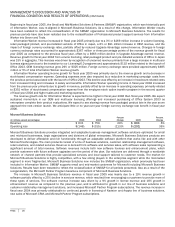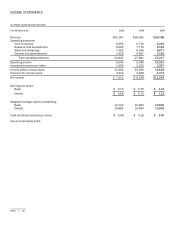Microsoft 2005 Annual Report Download - page 29
Download and view the complete annual report
Please find page 29 of the 2005 Microsoft annual report below. You can navigate through the pages in the report by either clicking on the pages listed below, or by using the keyword search tool below to find specific information within the annual report.
MANAGEMENT’S DISCUSSION AND ANALYSIS OF
FINANCIAL CONDITION AND RESULTS OF OPERATIONS (CONTINUED)
PAGE 28
to decline in fiscal year 2006. Profitability may decline in fiscal year 2006 as investments are made in the development of new
applications and services, the search and search monetization platform, and growth in the field sales force. MSN may from time
to time continue to make investments in improving the user experience and in some cases, the number of advertisements
delivered either via our search tools or via our Internet portals may be reduced to improve the overall user experience thereby
helping to sustain and grow our user base. Effective July 1, 2005, functions related to MapPoint in Mobile and Embedded
Devices have been moved to MSN. This reorganization will result in a corresponding change to the Mobile and Embedded
Devices and MSN reported results.
Mobile and Embedded Devices
(In millions, except percentages) 2003
2004
Percent
Change
2005
Percent
Change
Revenue $
156
$
247
58%
$337
36%
Operating loss $(277)
$(219)
21%
$ (46)
79%
Mobile and Embedded Devices includes Windows Mobile™ software, Windows Embedded operating systems, MapPoint®, and
Windows Automotive. These products extend the advantages of the Windows platform to mobile devices such as PDAs, phones,
and a wide range of embedded devices. The business is also responsible for managing sales and customer relationships for
Microsoft overall with device manufacturers and communication sector customers. The communication sector includes network
service providers (such as wireless, wireline and cable operators), and media and entertainment companies. The market for
products in these segments is intensely competitive. Competitive alternatives vary based on product lines and include product
offerings from commercial and non-commercial mobile operating system providers, and proprietary software developed by
OEMs and mobile operators. Short product lifecycles in product lines such as Windows Mobile software may impact our
continuing revenue streams.
Mobile and Embedded Devices revenue growth for fiscal year 2005 was primarily due to unit volume increases in all major
product lines, especially Windows Mobile software sales and Windows Embedded operating systems. Increased revenue for
Windows Mobile software was primarily driven by increased market demand for connected mobile devices such as phone-
enabled PDAs and Smartphones, and strong growth in volume shipments for standalone PDAs. The increase in Windows
Embedded revenue was due to our operating system being included in new product designs for both new and existing
customers. Mobile and Embedded Devices also benefited from the increased demand for on-line mapping and the introduction
of new MapPoint finished goods products. This new functionality resulted in increased unit sales for Mobile, Embedded, and
MapPoint product categories. In fiscal year 2005, revenue for Windows Mobile software increased $46 million or 45%, revenue
for Windows Embedded operating systems increased $19 million or 21% and revenue for MapPoint and Windows Automotive
increased $25 million or 45%. Mobile and Embedded Devices realized positive increases in customer satisfaction ratings from
both mobile operator partners and the developer community. In fiscal year 2005, Mobile and Embedded Devices released
Windows Mobile 5.0 which is the latest version of our mobile operating software. Unit volume increases drove revenue growth
for fiscal year 2004 over fiscal year 2003 in all major product lines. The growth was primarily due to the increased number of
OEMs and mobile operators shipping Windows Mobile software for Smartphones, increases in market share for our Pocket PC
and embedded products and increased usage by existing customers of our MapPoint Web Service.
Mobile and Embedded Devices operating loss for fiscal year 2005 decreased compared to fiscal year 2004 primarily due to a
decrease in stock-based compensation expense. The growth in revenue and a reduction in sales and marketing expense also
contributed to improved operating results in this period compared to the previous year. This improvement has been partially
offset by increased salary and benefit costs from increased hiring and increased investment in research and development. The
Mobile and Embedded Devices operating loss for fiscal year 2004 decreased compared to fiscal year 2003 primarily due to
growth in revenue and lower marketing expenses, partially offset by $58 million of stock-based compensation expense from the
employee stock option transfer program in the second quarter of fiscal year 2004.
Mobile and Embedded Devices is committed to continuing product innovation to meet the growing needs of our customers
and partners. We will continue to invest in research and development and sales and marketing to develop and market evolving
software solutions. In fiscal year 2006 we expect to bring added functionality to the Windows Mobile 5.0 platform through the
Windows Mobile 5.0 Messaging and Security Feature Pack and the Exchange Server 2003 Service Pack 2. This solution enables
business users to easily stay connected to their Microsoft Office Outlook Mobile information and helps businesses to better
protect device data. We expect sales for Mobile and Embedded Devices to continue to grow in fiscal year 2006. The growth is
anticipated to be driven by an overall increase in customer demand for connectivity, and an increase in the number of new
devices being offered by OEMs and mobile operators incorporating Windows Mobile software and Windows Embedded operating
























